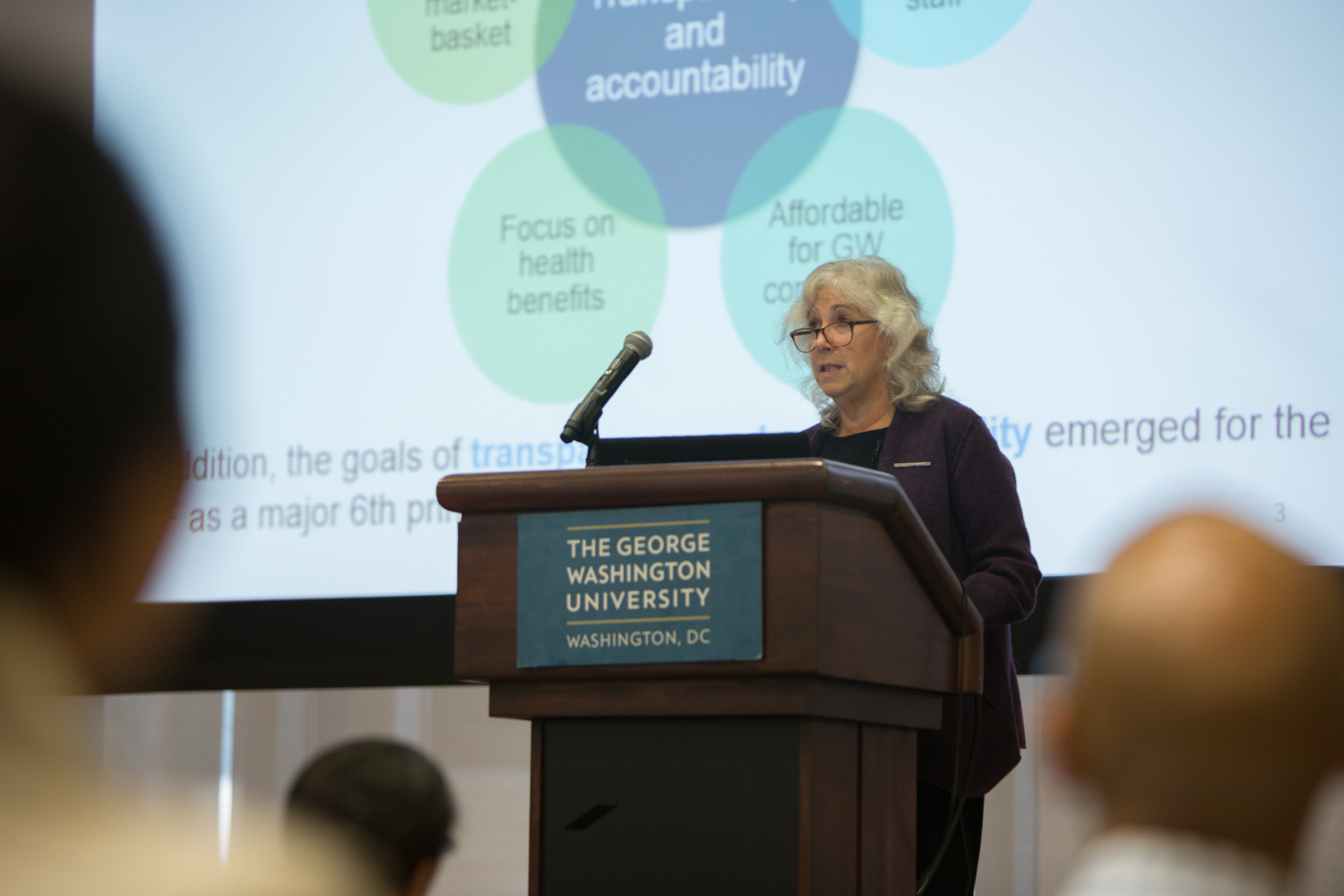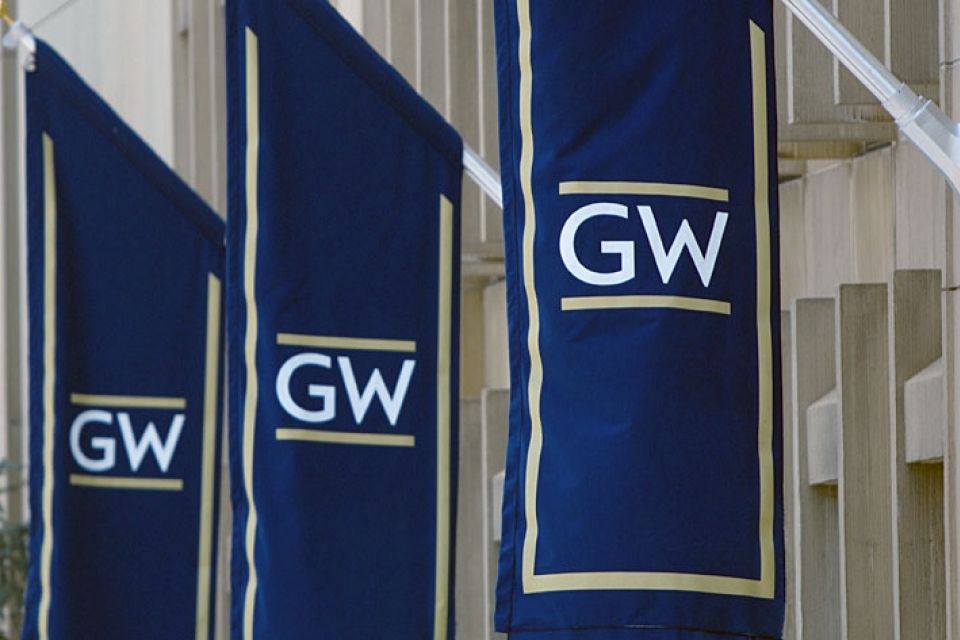After months of deliberation and research, a task force created by George Washington President Steven Knapp released its long-term recommendations Tuesday, emphasizing the need for transparency and community engagement as the university continues its efforts to shape future benefits offerings.
The 27-page report, which can be viewed in its entirety online, offered six recommendations from the Benefits Task Force—a group comprised of faculty and staff. The recommendations were on the topic of communication and engagement with GW employees. The task force included 19 options for consideration regarding health benefits, retirement benefits, retiree medical benefits, tuition benefits, paid leave and restructuring the university’s fringe pool.
For the recommendations and options, the task force emphasized the importance of grandfathering current benefit recipients, as well as giving employees appropriate lead time before benefit restructuring begins.
“Because of the time constraints and the number of recommendations contained in this report, the BTF has carefully evaluated the benefits landscape at GW and has identified options for strong consideration rather than fully developed recommendations with detailed costing estimates,” members of the task force wrote in the report. “Additional research and analysis by University Human Resources will be needed to determine which options offer the best combination of changes for the GW community. Many will have interactive budgetary and operational effects on employees, retirees and plan administration.”
Dr. Knapp, Vice President for Human Resources Sabrina Ellis and task force co-chairs Sara Rosenbaum and John Kosky spoke at Tuesday’s event, attended by more than 100 university faculty and staff. Ms. Rosenbaum and Mr. Kosky presented on the findings of the task force.
“What motivated this was our sense that we really needed to take a look at our benefits programs,” Dr. Knapp said. “We wanted to step back from the year-to-year work of the Benefits Advisory Committee and take a look at the longer-term perspective and ask a task force to do that. I think they’ve done an excellent job. [The report] is a very impressive piece of work.”
Focus on communication, engagement and health benefits
Created by Dr. Knapp in January to review the three major categories of GW benefits—health, retirement and tuition—and compare the benefits with those offered by peer institutions, the Benefits Task Force stressed the differences between recommendations and options in its long-term report.
“The tradeoffs and choices to be made are deeply important, and the BTF believes strongly that only the GW community as a whole can make these choices,” members of the task force wrote. “ … For this reason, the BTF makes its sole set of recommendations in the area of robust community engagement as a core principle of benefit transformation. Unlike our prior options, these recommendations receive the unanimous and enthusiastic support of the BTF precisely because the university will need employee input and buy-in as it moves forward to reshape benefits.”
Among its recommendations to bolster communications and engagement, the task force called for an internal review on the effectiveness of all HR communications, for the creation of a dedicated HR communications position accountable to the vice president of Human Resources, and implementing innovative tools, such as CastLight, to help employees understand benefits more clearly.
The task force also called for a review of the current composition of the Benefits Advisory Committee—a standing committee of faculty and staff charged with providing ongoing feedback to the university’s Human Resources and Benefits Administration. The review would ensure broad representation on the committee from divisions and schools and equitable distribution of membership among faculty, staff and administrative representatives.
The balance of the report included what the task force classified as “options” to improve GW’s benefits. Eleven of the 19 options focused on health benefits, including one to eliminate the university’s basic and medium health plans in favor of a stronger high-deductible plan that features a health savings account (HSA) backed by larger university contributions.
This high-deductible plan would be a more robust version of the one introduced by the university in 2015, Ms. Rosenbaum said. The proposed high-deductible plan would help GW and its employees navigate the disadvantages of the existing basic and medium plans, which have higher premiums, offer flexible savings accounts with less utility than HSAs and would likely be subject to deductible increases in the near future, Ms. Rosenbaum said.
“The clock is probably ticking down on the $500 deductible. We’re probably looking at a world where, in a couple of years, we’re paying $1,000 deductibles,” said Ms. Rosenbaum, the Harold and Jane Hirsh Professor of Health Policy at the Milken Institute School of Public Health. “We decided it was worth putting an option on the table that moves us to a high-deductible plan. Rather than sit around and wait for benefits to continue degrading, we thought we could make a move to a plan that has a much lower premium and a health savings account as long as the university will fund it enough so that the out-of-pocket effect for people would be not so much different from our current medium plan.”
Tuition and retirement options
Benefits for GW employees rank in the middle compared to those offered at 17 peer universities, according to a September benefits report prepared by Mercer, a leading global consultant on issues that include health and retirement benefits. That is a snapshot in time, said Mr. Kosky, associate vice president for HR talent management. The task force recommended that GW continue the practice of benchmarking by conducting the study each year so the community can see how GW ranks over time.
Options to modify the university’s retirement benefit could include reducing the university’s 403(b) match for employees hired beginning in 2017 from 6 percent to 3 percent for their first five years of eligibility, then increasing to 6 percent after those five years have been fulfilled.
Regarding tuition, the task force laid out options for GW to cover bachelor’s degrees at 100 percent for employees who do not already have one and to provide additional options, such as a 100 percent tuition remission rate for employees provided they fulfill a service payback requirement.
Employees in that scenario could opt for a slightly lower tuition remission rate but without a service payback requirement, Ms. Rosenbaum said.
“We cannot stress enough how important the task force felt tuition benefits are and will be going forward,” she said. “They are extremely valuable. One of the things we’ve been cognizant of is the importance of having sufficient funds in the fringe pool to do right by tuition benefits.”
Guiding principles shape report
In his charge to the task force in January, Dr. Knapp identified several guiding principles, noting that benefits must be sustainable over the long term, that they must not discriminate between faculty and staff and that they must be affordable to the GW community. He also said particular focus should be placed on employee and retiree health benefits and that GW’s benefits should remain competitive with its market-basket institutions over the long term.
The task force’s long-term report adhered to Dr. Knapp’s principles and added a sixth focused on transparency and communication, said Ms. Rosenbaum. It was that principle that shaped the group’s decision to differentiate between the recommendations and the options.
“Everybody on the campus has an enormous stake in the choices that get made,” she said. “In the end, benefits involve trade-offs. Those trade-offs vary depending on your age, your family status, your employment status and where you are in your own life cycle. Those are issues we couldn’t make for everybody. So we defined as our duty, at this point, to put options on the table.”
The recommendations and options will be reviewed by University Human Resources and the Benefits Administration in consultation with the Benefits Advisory Committee, Ms. Ellis said. The university anticipates the long-term report serving as a part of a multi-year benefits strategy, she added.
“HR and the Benefits Administration will look at the cost of these options, and we will be working very closely with the Benefits Advisory Committee,” she said. “That committee will convene in early January so we can start the work of looking at these and coming back with next steps.”
Employees with questions about the report or the work of the Benefits Task Force may contact Mr. Kosky at 202-768-0095.





